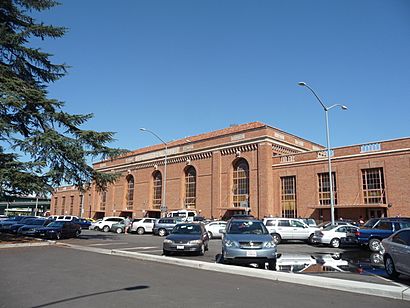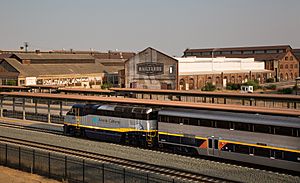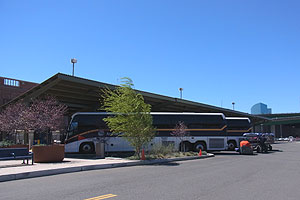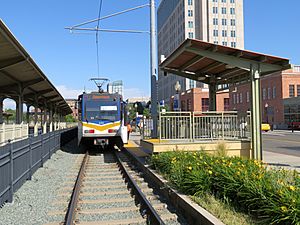Sacramento Valley Station facts for kids
Quick facts for kids
Sacramento Valley Station
Sacramento, CA |
|||||||||||||||||||||||||||||||||||||
|---|---|---|---|---|---|---|---|---|---|---|---|---|---|---|---|---|---|---|---|---|---|---|---|---|---|---|---|---|---|---|---|---|---|---|---|---|---|

Sacramento Valley Station in 2014
|
|||||||||||||||||||||||||||||||||||||
| Location | 401 I Street, Sacramento, California United States |
||||||||||||||||||||||||||||||||||||
| Coordinates | 38°35′05″N 121°30′02″W / 38.584791°N 121.500517°W | ||||||||||||||||||||||||||||||||||||
| Owned by | City of Sacramento | ||||||||||||||||||||||||||||||||||||
| Line(s) | UP Martinez Subdivision | ||||||||||||||||||||||||||||||||||||
| Platforms | 2 island platforms (Amtrak) 1 side platform (Light Rail) |
||||||||||||||||||||||||||||||||||||
| Tracks | 4 (Amtrak) 2 (freight) 1 (Light Rail) |
||||||||||||||||||||||||||||||||||||
| Connections | Amtrak Thruway Motorcoach | ||||||||||||||||||||||||||||||||||||
| Construction | |||||||||||||||||||||||||||||||||||||
| Parking | 288 long-term spaces 45 short-term spaces Fee: $3.60/hr ($10 daily maximum) |
||||||||||||||||||||||||||||||||||||
| Disabled access | Yes | ||||||||||||||||||||||||||||||||||||
| Architect | Bliss & Faville | ||||||||||||||||||||||||||||||||||||
| Architectural style | Late 19th And 20th Century Revivals | ||||||||||||||||||||||||||||||||||||
| Other information | |||||||||||||||||||||||||||||||||||||
| Station code | SAC | ||||||||||||||||||||||||||||||||||||
| Website | www.cityofsacramento.org/Public-Works/Sacramento-Valley-Station | ||||||||||||||||||||||||||||||||||||
| History | |||||||||||||||||||||||||||||||||||||
| Opened | 1926 December 8, 2006 (Gold Line) |
||||||||||||||||||||||||||||||||||||
| Traffic | |||||||||||||||||||||||||||||||||||||
| Passengers (2018) | 1,089,223 |
||||||||||||||||||||||||||||||||||||
| Rank | 2nd in California | ||||||||||||||||||||||||||||||||||||
| Services | |||||||||||||||||||||||||||||||||||||
|
|||||||||||||||||||||||||||||||||||||
|
|||||||||||||||||||||||||||||||||||||
|
Southern Pacific Railroad Company's Sacramento Depot
|
|||||||||||||||||||||||||||||||||||||
| NRHP reference No. | 75000457 | ||||||||||||||||||||||||||||||||||||
| Added to NRHP | April 21, 1975 | ||||||||||||||||||||||||||||||||||||
The Sacramento Valley Station (SAC) is a busy train station in Sacramento, California. You can find it at 401 I Street, right on the corner of Fifth Street. It's one of the busiest Amtrak stations in the whole country! Thousands of people use it every day, with over a million passengers each year.
Today, many Amtrak and Amtrak California trains stop here. You can also catch Amtrak Thruway Motorcoach buses, which connect to trains. The station is also the last stop for the Sacramento RT Gold Line light rail system.
Contents
What Services Does the Station Offer?
Amtrak Trains
Sacramento Valley Station is served by four different Amtrak train routes. There are two daily long-distance routes and two shorter "corridor" routes with many trains each day. In total, about 38 trains stop here on weekdays and 30 on weekends.
The California Zephyr and Coast Starlight are long-distance trains. They travel across many states, with one train going in each direction every day.
The San Joaquins route runs from Bakersfield to Sacramento. You can also connect to more San Joaquins trains that go to Oakland by using an Amtrak bus.
The Capitol Corridor is a very popular route. It runs 15 times on weekdays and 11 times on weekends. Sacramento is usually the last stop for these trains, but one train each day continues to Auburn.
This station is very popular! In 2017, it was the second busiest Amtrak station in California. It's also the seventh busiest Amtrak station in the entire United States.
Amtrak Thruway Buses
Amtrak also runs special buses called Thruway Motorcoaches from Sacramento Valley Station. These buses help passengers connect to train services.
Here are some of the places these buses go:
- Redding – Chico – Sacramento – Stockton
- Lake Tahoe/Stateline – Sacramento
- Reno/Sparks – Colfax – Roseville – Sacramento
It's important to know that you usually need to travel on a train as part of your trip if you use these buses. This rule helps prevent the buses from competing with other private bus companies. However, the Lake Tahoe route is an exception.
Light Rail and Local Buses
Sacramento Valley Station is the last stop for the Gold Line light rail. This is one of the routes of the Sacramento RT Light Rail system. The station has a special platform for the light rail trains.
You can also catch local RT bus routes #30 and #38 right at the station. Many other local and commuter buses also stop nearby in downtown Sacramento.
Future Travel Plans
There are exciting plans for the future of Sacramento Valley Station!
- The Altamont Corridor Express (ACE) train system might add a new line from Modesto to Sacramento.
- Sacramento is also planned to be the northern end of the California High-Speed Rail system. This would bring very fast trains to the station.
There are also plans to make the station even better for buses. This might allow Greyhound Lines to use the station too, even though their current terminal is a mile away.
Station History
Early Days and Design
The current Sacramento Valley Station building was built in 1926. It was designed by a famous architectural firm called Bliss and Faville. The building has a beautiful style called Renaissance Revival, with a red tile roof and large arches.
Inside the waiting room, you can see a large painting by artist John A. MacQuarrie. This painting shows the start of the First Transcontinental Railroad in Sacramento back in 1863. This historic railroad connected the eastern and western parts of the United States.
The station was first owned by the Southern Pacific Railroad. Later, when Amtrak was created in 1971, it became an Amtrak-only station. In 1975, the station was added to the National Register of Historic Places. This means it's an important historic building!
For many years, only long-distance trains like the California Zephyr and Coast Starlight stopped at Sacramento. But in 1991, a new service called the Capitols (now the Capitol Corridor) began. This new service became very popular and helped make Sacramento Valley Station one of the busiest in the Western United States.
The Sacramento Regional Transit Gold Line light rail service was extended to the station on December 8, 2006.
Renovation and Future Plans
The City of Sacramento has been working on a big project to renovate and improve the station. This project has several stages.
The first stage, finished in 2012, moved the main Amtrak train platforms about 1000 feet north. The light rail trains stayed in their original spot behind the station building.
The second stage involved a lot of work on the station building itself. This included making the building stronger, replacing windows, and making it easier for everyone to use (like adding ramps for wheelchairs). The Amtrak ticket and baggage offices were also moved to a new, more passenger-friendly spot. This renovation was officially finished in 2017.
The third and final stage will bring even more improvements. This includes changing the light rail tracks, adding a new bus area, and building a raised walkway to connect the station to the new Railyards development nearby. There are also plans for new bike trails and possibly an expansion of the California State Railroad Museum.
Eventually, the historic station building might be used for other things as new transportation centers are built. The long-term plan also includes adding a Sacramento Streetcar project and making it possible for light rail trains to travel through the station in a loop.





